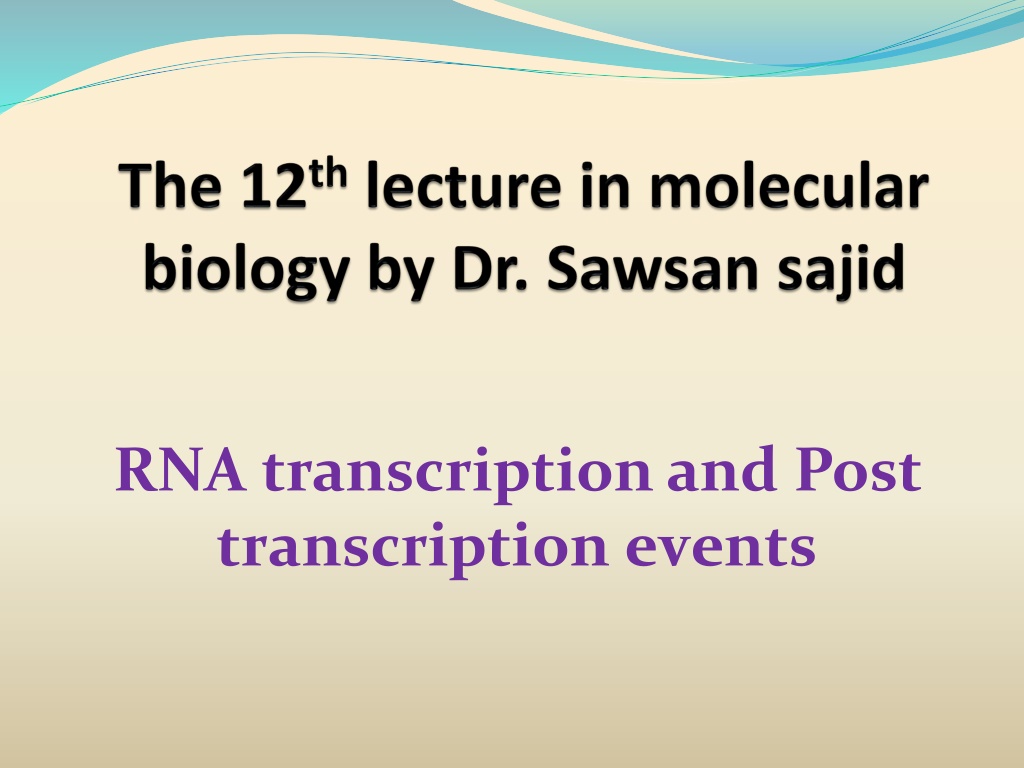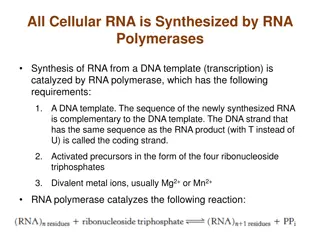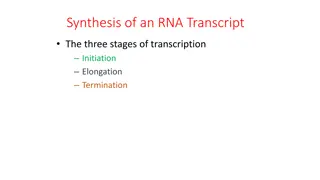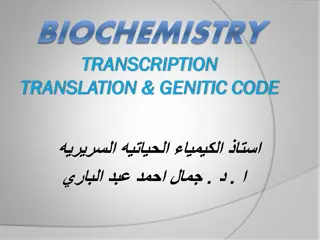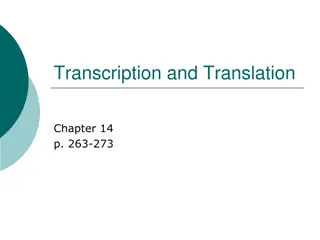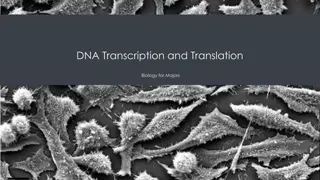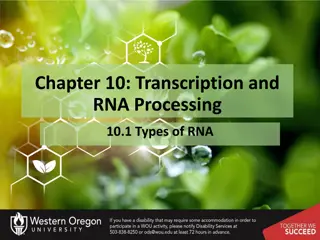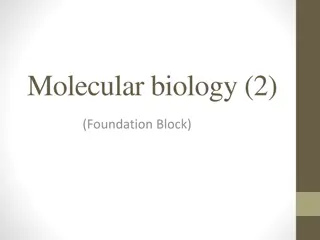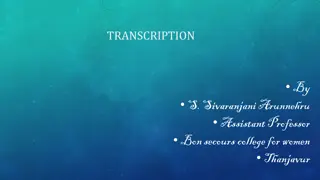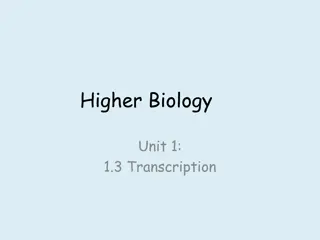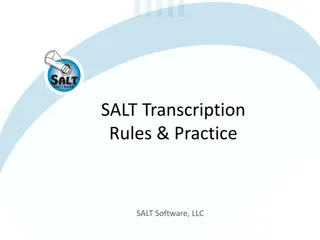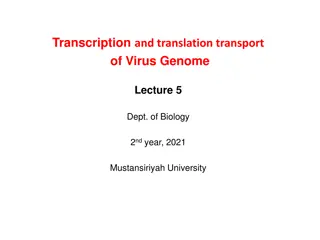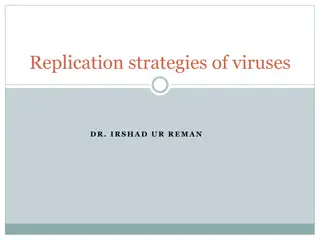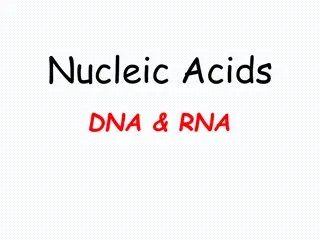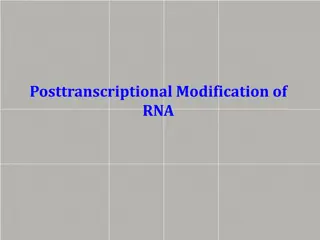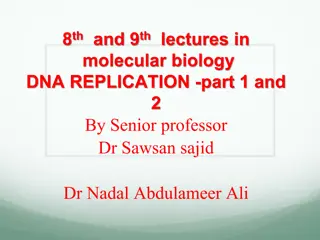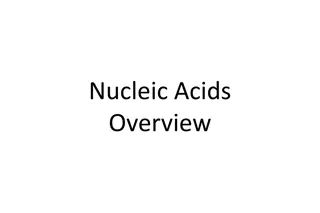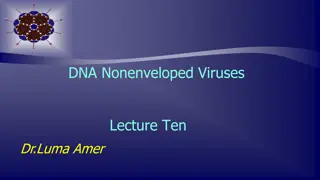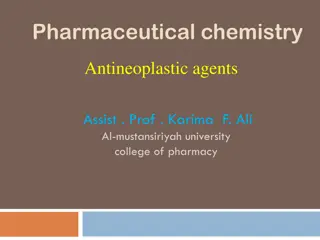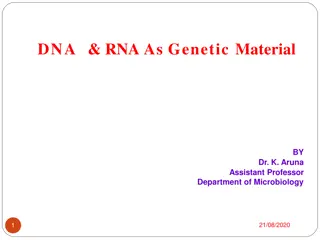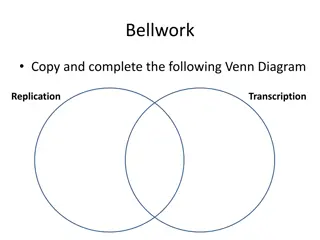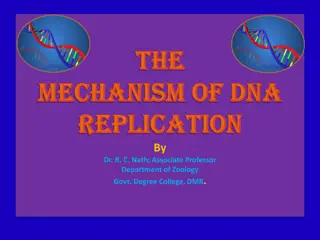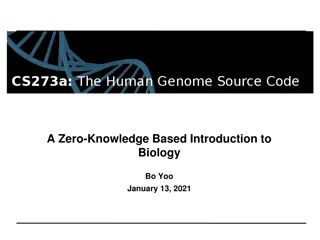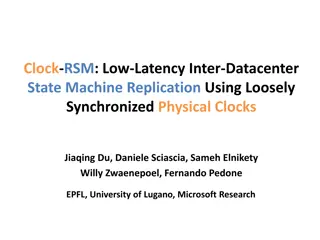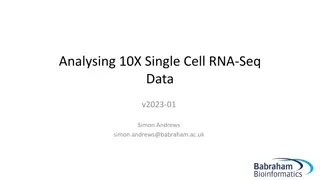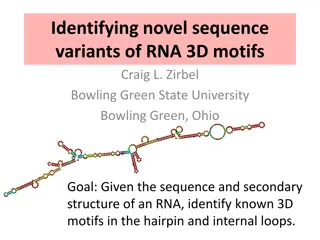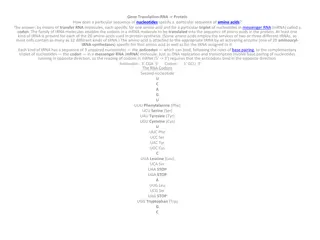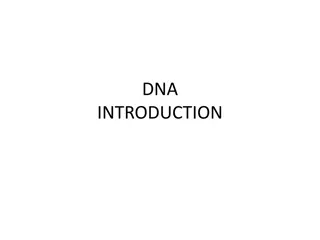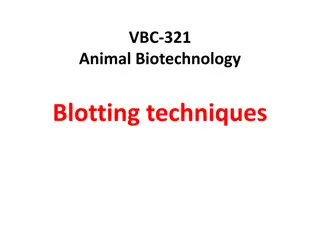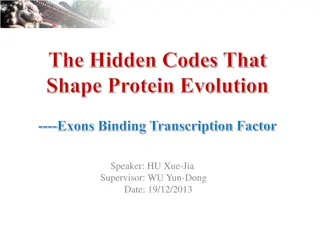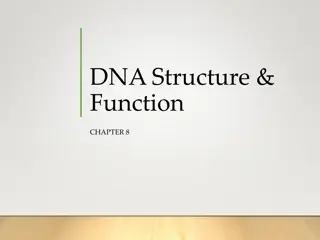Differences Between DNA Replication and RNA Transcription
This content discusses the general variances between DNA replication and RNA transcription, highlighting their purposes, processes, enzymes involved, timing, and more. It delves into the initiation, template, and involved areas of replication and transcription, as well as key DNA regions like promoters, coding regions, and terminators. Additionally, it explores the distinctions between prokaryotic and eukaryotic promoters, detailing their structural differences and elements.
Download Presentation

Please find below an Image/Link to download the presentation.
The content on the website is provided AS IS for your information and personal use only. It may not be sold, licensed, or shared on other websites without obtaining consent from the author. Download presentation by click this link. If you encounter any issues during the download, it is possible that the publisher has removed the file from their server.
E N D
Presentation Transcript
RNA transcription and Post transcription events
General differences between transcription and replication: Replication Transcription purpose The conserve the entire genome for next generation. purpose of replication is to The purpose of transcription is to make RNA copies of individual genes that the cell can use in the metabolic activity Definition DNA replication is the replication of a strand of DNA into two daughter strands, each daughter strand contains half of theoriginal DNA double helix. synthesis of RNA from a DNA template. 3 types will transcribed ,r RNA and t RNA are final product ,m RNA will translated to protein products One strand of DNA becomes 2 daughter strands. mRNA, tRNA, rRNA and non- coding RNA( like microRNA) Timing It happened once the cell startdivision At any time in thecell as required Enzyme and results The two strands are separated and then each strand's complementary sequence is synthesized polymerase. The primers. the codons of a gene are copied into messenger RNA by RNA polymerase. With the help of transfer RNA, which carries amino acids and r RNA the codon will translated to protein . The process required promoter DNA DNA by process required
differences Replication Transcription Initiation need primer ,DnaA box & initiation protein Require promoter region Only template strand(3 5) Template The 2 strands serve as a template Involved area The total genome will replicate precise part will transcribed the direction of movement and polymerization of RNA polymerase from 5 3 .The transcript sequence(complete gene ) start with promoter region where the DNA will opened and the RNA polymerase bind to start transcription .After promoter region another region come called +1 (beginning of transcription )then the coding region followed by Terminator .All the mentioned region represent complete structure for one gene
Identifications : 1- promoter ( (40-60 nts) at the beginning of every gene located upstream (towards the 5' region) of a gene(in prokaryote more than one gene shard the same promoter unlike Eukaryotic cell ) on the template or sense strand. in this site the two DNA strand will opened but it is un translated area. In prokaryotes, the promoter is recognized by RNA polymerase ( sigma sub unite).There are great differences between promoter area of Pro and Eukaryotic. 2- Coding region : Nucleotide sequences which will detriment the genetic code then will translated to Amino acid .it start with ATG triplet initiation codon (AUG in m RNA). 3- Terminator ( ):Nucleotide sequences exist after the coding region rich with poly G followed by poly C then poly A ): a regulatory nucleotide sequences of DNA
Difference between Eukaryotic and Prokaryotic Promoters 1- Prokaryoticpromoters the promoter consists of two short sequences know as -10 box and -35 box positions upstream from the transcription start site. The sequence at -10box is also called the Pribnow box(according to David Pribnow how discover this elements 1975) , or the -10 element, and usually consists of the six nucleotides TATAAT. The Pribnow box is absolutely essential to start transcription in prokaryotes since it rich with T & A nitrogen bases . The other sequence is -35 box ( -35 element) usually consists of the six nucleotides TTGACA. RNA polymerase attached here via its sigma unit . The two boxes separated by 17 1 base pairs .
There are differences between promoter region in pro and Eukaryotic cell and for sure this promoter region will not translate to protein Eukaryotic promoters more complicated 1- regulatory promoter to regulate promoter activity. 2-core promoter :divided to many region A- recognition element at -35 box(in other reference -30 or -75)in all cases it is rich with GC nts thus DNA will not opened here B- TATA box at -25 box (in other references at -26 or -29 ) as with -10 box in prokaryotic it is rich with AT nts thus the two DNA strand will opened here( it located 25 nts far away from the start point +1 ). Discovered by David Hogness in 1977 thus it is called Hogness box.RNA polymerase will bind to -35 box C-initiator elements(Inr) : represent transcription start point (from -2 to +4)including +1 D-Down stream core promoter element(DPE): note: TATA Inr DPE approximately 80bp play critical role in transcription process . After that the codon region come with only one gene sequence cos it is monocistronic . and divided to many sub regions to as with prokaryotic promoter . but the strand opened here. at +20 to +32 region
Types of Eukaryotic RNA polymerase. The 3 main types I,II, III beside there are type IV and V in plant Type of Polymerase Responsible to Produce Location RNA Polymerase I rRNA(18 s , 5.8s, 28s) nucleolus RNA Polymerase II mRNA and small nuclear RNA nucleoplasm RNA Polymerase III tRNA and 5s r RNA nucleoplasm
1-Initiation stage : RNA polymerase action and role of sigma factor RNA polymerase binding in bacteria: involves recognizing core promoter region by sigma factor then binding to -35 box After binding to the DNA, the RNA polymerase switches from a closed complex to an open complex at -10 box . This change involves the separation of the DNA strands to form an unwound DNA strand of approximately 13 bp, referred to as the transcription bubble. Ribonucleotides are base-paired to the template DNA strand, according to Watson-Crick base-pairing interactions. 20 - 17 At the beginning sigma factor will bind to promoter region when the holo-enzyme reach +1 region it will start adding 9-10 nts according to complementary without moving after that sigma factor will release leaving the core enzyme continue its work transcribed the total gene sequence
The figure represent binding RNA molecules to promoter region at -35 box then to -10 box at the upstream region from the coding region which represent the Movement will be from 5 3 end as in replication stream down region .
The figure represent transcription initiation complex consist from RNA polymerase binding to DNA template strand which read from 3 5 (not coding strand which read 5 3) .sigma sub unit bind to -35 box then moved to -10 box in which the DNA strand opened . Transcription start at +1 position
Second step: Elongation As transcription progresses, ribonucleotides are added to the 3' end of the RNA transcript and the RNAP complex moves along the DNA. The enzyme is highly possessive ,it can add 30 nts \sec . Although RNAP does not seem to have the 3'exonuclease the proofreading activity found in DNA polymerase, there is evidence of that RNAP will halts ( ) at mismatched base-pairs and correct it. activity that characterizes
Termination: In prokaryotes can be rho-independent or rho-dependent 1-Rho-independent termination (also called Rho-independent termination) is a mechanism in prokaryotes that causes RNA transcription to be stopped without the aid of rho protein. When Transcription process reached a region called TERMINTATOR or attenuator this will causes the formation of a "hairpin" structure from the RNA transcription looping and binding upon itself. This hairpin structure is often rich in G-C base-pairs, making it more stable than the DNA-RNA hybrid itself. So In this mechanism, the mRNA contains a sequence that can base pair with itself to form a stem-loop structure(7-20 repated CG thus RNA here will be double stranded)These bases form three hydrogen bonds between each other strong. Following the stem-loop of uracil residues (in the DNA there will poly A ) . The bonds between uracil and adenine are very weak. A protein (nusA) binds to RNA polymerase and the stem-loop structure tightly enough to cause the polymerase to temporarily stall Adenine-Uracil bonds lower the energy of destabilization for the RNA-DNA duplex, allowing it to unwind and dissociate from the RNA polymerase. transcription termination:Intrinsic therefore are particularly structure is a chain . The weak
Rho-dependent termination: (Rho factor) is a prokaryotic ATP-dependent unwinding enzyme involved in termination transcription terminator sit by moving along the newly forming RNA molecule towards its 3' end and unwinding it from the DNA template thus it will release RNA polymerase from the transcription elongation complex leaving RNA molecules free . transcription binds to the .
Post transcriptional events :each of transcript RNA type will subjected to modification events after ending transcription as follow : for rRNA, at beginning it produced as one precursor unit ,in Eukaryotic cell known as 45s pre- RNA it will methelated & cleaved by endonuclease enzyme beside removing all the spaces(spacers) between rRNA types to convert to mature18s, 5.8s and 28s the
The same events will happened with prokaryotic rRNA . it produced as one segment known as 30s pre-rRNA then it will cleaved by endonuclease followed by Trimming( )by exonuclease enzyme to convert it to mature 16s,23s and 5s beside the transcript tRNA
For tRNA molecules ,post transcriptional events include modification of some nitrogen base like pseudouridin and thymine ( complicated in Eukaryotic cell which involve 1-removel of leader sequence from 5 end 2-replcament of nts at 3 end with CCA3 OH (Acceptor arm) 3- chemical modification of some nitrogen base 4- Excision of intron region , )but it is more
Modification of m RNA :usually m RNA in prokaryotic cell not modified after transcription cos it will be translated to protein immediately but in Eukaryotic cell there will a lot of modification which take place till reaching the final mature form 1- processing: adding cap structure at 5 end and poly A tail to 3 end 2- splicing : involve removing all the introns (non coding region )keeping only the exons to create complete sequence for one gene , usually the transcript m RNA is shorter than the origin gene it self , this modifications include
mRNA Processing: Eukaryotic pre-mRNA receives a 5' cap and a 3' poly-A tail before introns are removed and the mRNA is considered ready for translation. 1- For the processing it include 1 -adding cap structure at 5 end to protect mRNA from degradation by endonuclease enzyme thus it may remain for days . Cap structure formed by addding 3 phosphate group for 5 end followed by adding Guanosine residue to form guanosine tri phosphate then guanosine will methylated at 7 carbon atom to become 7 methyl guanosin (m7 G cap) . 2-Polyadenylation (poly Adenine residue ) is the addition of poly(A) tail to a primary transcript mRNA. The poly(A) tail consists of multipleadenosine monophosphates; In eukaryotes, polyadenylation is part of the process that produces mature messenger RNA (mRNA) for translation. the poly(A) tail will protects the mRNA molecule from enzymatic degradation in the cytoplasm and aids in transcription termination. The enzyme responsible for adding poly A residues, is called polyadenylate polymerase.
2- before protein synthesis): Eukaryotic genes are composed of exons, which correspond to protein-coding sequences and intervening sequences called introns (non expressed sequence) which may be involved in gene regulation, but are removed from the pre-mRNA during processing. All introns in a pre-mRNA must be completely removed before protein synthesis. 1-The first cleavage occur by Splicesome machine at 5 end of the intron region rich with GU residue 2- then the intron bend back ( form lariat structure via 5 3 phosphodiester bond 3- cleavage at 3 end of the intron to completely released 4- joining the exons by ligase enzyme to give arise to mature mRNA Pre-mRNA Splicing (Introns are removed from the pre-mRNA )to .
The process of removing introns and reconnecting exons is called splicing. Introns are removed and degraded while the pre-mRNA is still in the nucleus. The splicing of pre-mRNAs is conducted by complexes of proteins and RNA molecules called spliceosomes . The spliced m RNA now is ready for TRANSLATION , the last step in gene processing ( )
